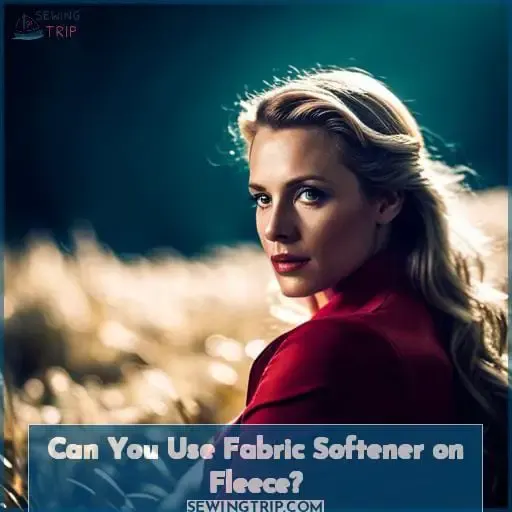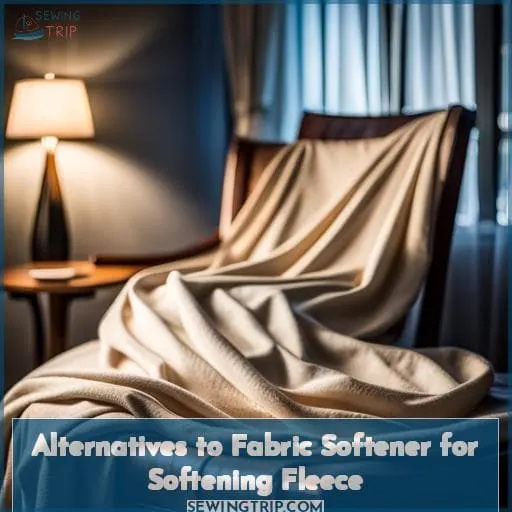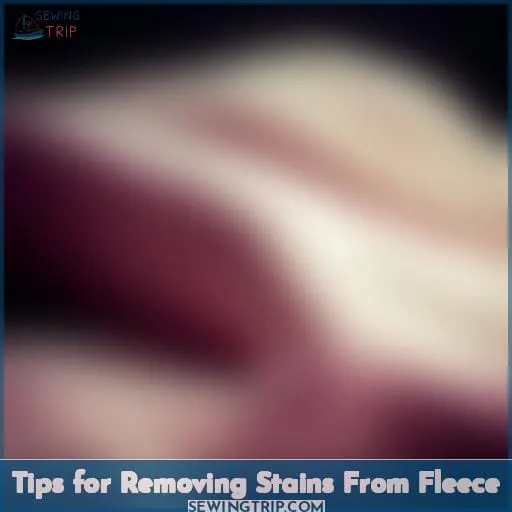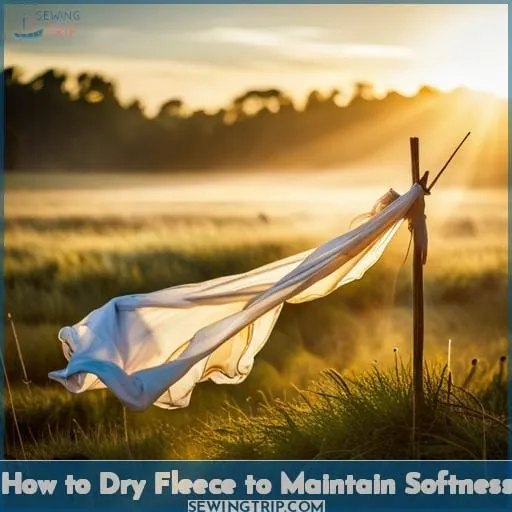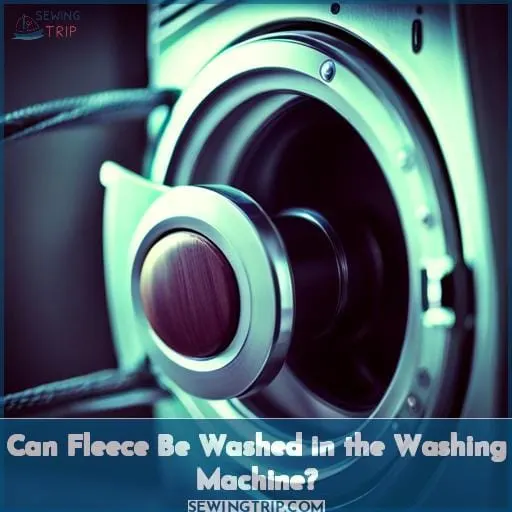This site is supported by our readers. We may earn a commission, at no cost to you, if you purchase through links.
 Looking to keep your fleece soft and cozy without using fabric softener? In this article, we’ll explore why avoiding fabric softener on fleece is the way to go. Discover the negative effects of fabric softeners on fleece, such as reduced absorbency and ruined wicking properties.
Looking to keep your fleece soft and cozy without using fabric softener? In this article, we’ll explore why avoiding fabric softener on fleece is the way to go. Discover the negative effects of fabric softeners on fleece, such as reduced absorbency and ruined wicking properties.
But don’t worry! We’ll also provide alternative options that will help you maintain the plushness of your favorite fleece items.
Table Of Contents
- Key Takeaways
- Can You Use Fabric Softener on Fleece?
- Why Should You Avoid Fabric Softener on Fleece?
- Alternatives to Fabric Softener for Softening Fleece
- How to Properly Wash Fleece Items
- Tips for Removing Stains From Fleece
- How to Dry Fleece to Maintain Softness
- How Often Should You Clean Fleece Items?
- Can Fleece Be Washed in the Washing Machine?
- Frequently Asked Questions (FAQs)
- Conclusion
Key Takeaways
- Fabric softener can have negative effects on fleece, including interfering with flame retardant properties, static reduction capabilities, natural insulation, and moisture-wicking capabilities.
- There are alternatives to fabric softener for softening fleece, such as using baking soda and vinegar, brushing techniques, and using dryer sheets.
- Proper washing of fleece items involves checking care labels, using a gentle cycle with cold water, choosing mild detergent, and incorporating odor control agents if needed.
- When selecting a detergent for fleece, it is recommended to choose one formulated for delicate fabrics, consider stain removal efficiency, maintain a gentler water temperature, and ensure fabric compatibility.
Can You Use Fabric Softener on Fleece?
You can use fabric softener on fleece, but it’s recommended to avoid it due to potential chemical reactions.
Fabric softeners contain chemicals that may react with the flame retardant properties of synthetic fleece, compromising its safety. Additionally, fabric softeners can interfere with the static reduction capabilities of fleece and affect its natural ability to insulate and retain warmth.
Fortunately, there are natural alternatives available for softening fleece without using fabric softener. Baking soda and white distilled vinegar are effective options that don’t pose any risks or cause chemical reactions.
When washing your fleece items in a washing machine, consider using a gentle cycle with cold water to prevent damage. It’s also important to use a mild detergent specifically designed for synthetic fabrics like polyester or microfiber.
By avoiding fabric softener and utilizing proper washing machine techniques along with natural alternatives like baking soda and vinegar, you can keep your fleece garments cozy without compromising their quality or safety features such as flame retardancy.
Why Should You Avoid Fabric Softener on Fleece?
To maintain the quality and functionality of your fleece garments, it’s important to avoid using fabric softener.
Fabric softeners can have negative effects on fleece, including:
- Reducing its longevity
- Impacting its moisture-wicking capabilities
Chemical reactions between fabric softener and synthetic fleece materials can compromise the performance of the fabric.
Additionally, safety considerations should be taken into account when caring for guinea pigs that use fleece bedding or clothing, as certain substances in fabric softeners may cause allergic reactions or irritate their feet.
It’s recommended to follow care label instructions for washing and avoiding the use of fabric conditioners on synthetic textures like fleece in order to ensure optimal performance and comfort while maintaining safety standards for both humans and animals alike.
Alternatives to Fabric Softener for Softening Fleece
For maintaining the softness of your fleece without resorting to fabric softeners, consider incorporating natural alternatives into your laundry routine. Occasionally, opting for baking soda or white distilled vinegar in your wash cycle can effectively soften fleece without compromising its quality.
- Vinegar Method: Adding 1/2 cup of white distilled vinegar to the rinse cycle helps break down any residue and leaves fleece feeling softer.
- Brushing Technique: Vigorously brushing damp fleece with a stiff brush can help restore its fluffiness and remove any stiffness caused by washing.
- Dryer Sheet Tips: Using dryer sheets made specifically for reducing static cling can also help soften fleece while minimizing static buildup.
By utilizing these natural alternatives and techniques, you can maintain the softness of your favorite fleeces while avoiding potential damage from fabric softeners.
How to Properly Wash Fleece Items
To properly wash fleece items, start by checking the care label for specific instructions.
Use a gentle cycle on your washing machine and choose a mild detergent that’s suitable for synthetic fabrics.
Avoid using bleach as it can harm the material.
Set the water temperature to cold or lukewarm to prevent any damage to the fleece fibers.
Washing Machine Settings and Temperature
Set your washing machine to the gentle cycle and use a cool or lukewarm water temperature when washing fleece items.
Optimal washing machine settings are crucial for preserving fleece softness.
Choose a mild detergent suitable for fleece, ensuring effective stain removal without compromising the fabric.
This meticulous approach to washing fleece correctly extends the lifespan of your garments, maintaining their plush feel.
Proper washing machine settings, coupled with a gentle cycle and cold water, contribute to the overall care of your fleece items.
Detergent Recommendations for Fleece
When washing your fleece items, use a detergent specifically formulated for delicate fabrics.
Opt for stain removal efficiency by choosing a product compatible with fleece properties.
Maintain water temperature on the gentler side to prevent damage to fleece fibers.
Consider incorporating odor control agents like vinegar during the wash cycle.
Ensure fabric compatibility for optimal results, keeping in mind the impact of detergents on fleece’s insulating qualities.
This careful approach guarantees a thorough yet gentle cleansing process.
Tips for Removing Stains From Fleece
Removing stains from fleece requires gentle yet effective methods to preserve its softness and integrity.
- Spot Cleaning Strategies:
- Tackle stains promptly with a mild dishwashing liquid, applying it directly without blotting to prevent fiber damage.
- Lint Roll for Delicate Care:
- Use a lint roller to remove loose debris before washing, ensuring a cleaner surface for stain treatment.
- Follow Laundry Symbols:
- Adhere to garment care symbols to select the appropriate washing conditions, such as using the delicate cycle for fleece items.
These stain removal techniques, coupled with proper care, will help maintain the quality of your fleece items, ensuring they stay soft and free from blemishes.
How to Dry Fleece to Maintain Softness
To preserve the softness of your fleece items, consider air-drying them or using a no-heat setting in the dryer, maintaining the fabric’s plush texture without compromising its quality.
- Air-Drying: Opt for line drying on dry days to minimize static and prevent overdrying. Shake and hang fleece garments for quick, natural drying.
- No-Heat Dryer Setting: Fluff fleece in the dryer with a no-heat setting to reduce static cling without subjecting the fabric to high temperatures.
- Static Reduction: Combat static by lightly spraying fleece with water if needed. Additionally, try using dryer sheets efficiently or employ a no-heat drying option to minimize static and pilling, especially crucial for high-quality fleece like Malden’s.
How Often Should You Clean Fleece Items?
For optimal fleece maintenance, assess the frequency of cleaning your fleece items to strike a balance between cleanliness and preserving their softness and functionality.
-
Follow Laundry Symbols: Pay attention to laundry symbols on the label of your fleece items. These symbols provide guidance on appropriate washing methods, helping you avoid damage caused by incorrect washing techniques.
-
Regular Washing Frequency: While fleece is known for its durability, regular washing is essential to prevent the accumulation of dirt, oils, and odors. Aim for a consistent washing routine to maintain the freshness and longevity of your fleece garments.
-
Air Drying Benefits: Whenever possible, opt for air drying. Air drying helps preserve the natural softness of fleece while minimizing exposure to heat, which can have detrimental effects on the fabric. This method is especially effective in preventing pilling and maintaining the overall quality of your fleece items.
Can Fleece Be Washed in the Washing Machine?
Transitioning from discussing the frequency of cleaning fleece items, let’s delve into the pivotal question: Can Fleece Be Washed in the Washing Machine? Emphatically, yes. The modern marvel of washing machines offers a convenient solution for maintaining your fleece items.
However, the devil lies in the details—ensuring machine-friendly care to enhance fleece longevity.
| Aspect | Guideline | Rationale |
|---|---|---|
| Machine Settings | Use a gentle cycle to prevent excessive friction. | Preserves the delicate fibers, minimizing shedding. |
| Water Temperature | Opt for cool water to prevent damage and shrinking. | Guards against heat-induced deformation of the fabric. |
| Detergent Selection | Choose a mild detergent to maintain natural fleece feel. | Harsh chemicals can erode fibers and reduce softness. |
| Lint Roller Assistance | Employ a lint roller after washing to tackle microfibers. | Minimizes shedding and maintains a pristine appearance. |
Mastering these machine-washing intricacies ensures your fleece items endure, combining convenience with effective care.
Frequently Asked Questions (FAQs)
Can fabric softener impact the color vibrancy of fleece over time?
Fabric softener can gradually dull the color vibrancy of fleece over time. The chemicals in softeners may contribute to fading.
To maintain long-lasting color, opt for alternative softening methods that preserve the integrity of fleece fibers.
What are the potential effects of fabric softener on the flame resistance of fleece, and is there a way to restore flame-retardant properties?
Fabric softener compromises flame-retardant properties of fleece.
Chemical interaction weakens resistance, risking easier ignition.
No method guarantees full restoration; alternative softeners,
like baking soda and vinegar, maintain safety.
Exercise caution, prioritize fleece integrity over unnecessary treatments.
How does fabric softener influence the durability of fleece, particularly in terms of preventing pilling and maintaining fabric integrity?
Fabric softener compromises fleece durability, promoting pilling and diminishing fabric integrity.
Opt for natural alternatives like vinegar or baking soda to maintain fleece quality without sacrificing durability or warmth.
Are there specific considerations or precautions when using fabric softener on fleece items designed for outdoor activities, such as hiking or camping gear?
For optimal outdoor fleece performance, avoid fabric softeners. Chemical interactions may compromise water repellency, flame resistance, and moisture-wicking capabilities crucial in hiking or camping gear.
Preserve fleece integrity by opting for natural softening methods like vinegar or baking soda.
Can the use of fabric softener on fleece affect its suitability for DIY projects involving fabric paints or other creative endeavors?
Employing fabric softener on fleece hampers adhesion for DIY projects like fabric painting. Chemical reactions may impede paint adherence. Opt for natural softening alternatives, preserving fleece integrity while fostering creative endeavors.
Conclusion
In navigating the labyrinth of fleece care, forsaking fabric softener emerges as the beacon to preserve the sumptuousness of your cherished items. The detrimental repercussions on absorbency and wicking properties can’t be overstated.
Fear not the rigidity of fabrics; embrace the allure of irresistibly cuddly warmth. Delve into alternatives that defy the tyranny of traditional softeners, safeguarding the plushness of your fleece.
Elevate your fleece-softening game by washing with precision, removing stains judiciously, and mastering the art of drying.
Bid farewell to the softener saga; revel in the fleece-softening odyssey.

